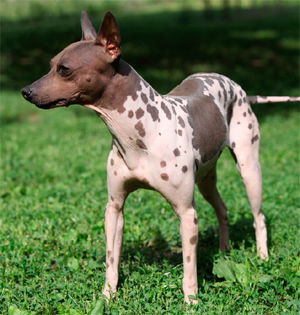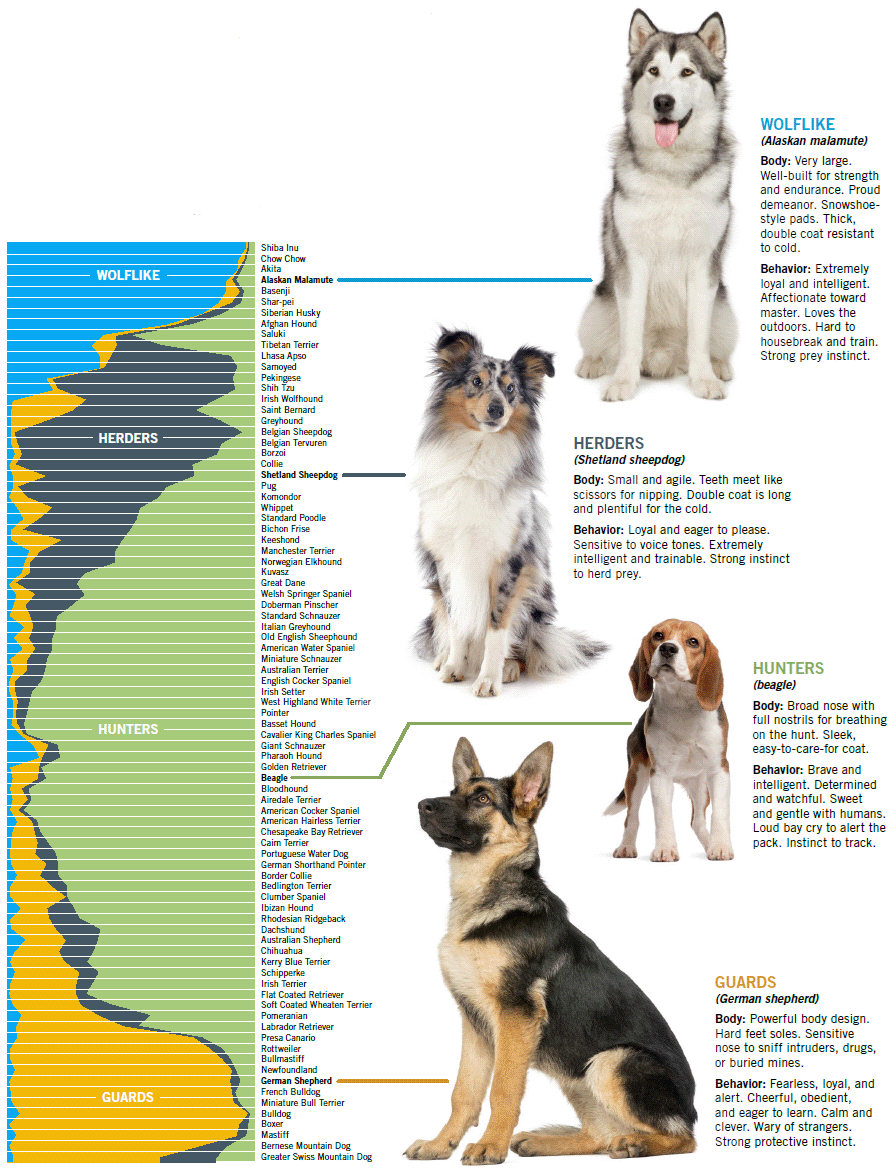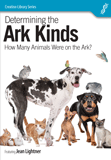
Suite Dogs
God designed “man’s best friend” to produce a vast array of types, each with a suite of traits just right for a special need.
The American hairless terrier is one of the newest official dog breeds, recognized by the United Kennel Club in 2004. Just in time, too. Allergies have reached epidemic proportions, forcing many sufferers to miss out on one of life’s basic pleasures. Now an adorable dog is available for them, too—the perfect lap size and no shedding. These dogs’ natural intelligence and calm temperament make them excellent companions. They are also curious, active, courageous, and playful. Humans had a need, and presto, we could breed a dog to meet those needs. Just coincidence?
Centuries ago, English breeders saw another need—a massive dog that could guard, do search and rescue, and assist police work. So the English mastiff was born. It is, in fact, the heaviest breed on record, tipping the scales at 343 pounds (156 kg). These gentle giants have an amiable nature. They love families and desire to please.
Biologists are puzzled how tiny genetic changes can produce so many dog varieties in such a short time.
How could any two animals be more different? And these are just two of the 500 dog breeds around the world!
Even more amazing, the vast majority of these breeds are fewer than 500 years old. Indeed, most are fewer than 150 years old. Biologists are puzzled about how tiny genetic changes can produce so many dog varieties in such a short time.1 As a matter of fact, no other mammal has the same range of variation.
How could these diverse suites of traits appear so quickly, rather than by slow, chance processes over thousands of generations? The only reasonable explanation for such complex, elegant, preprogrammed genetic systems is that they were designed that way.
Origin of Dogs from Wolves
God displays His nature so clearly in His creatures that all people are without excuse (Romans 1:20). That display includes dog breeds. Charles Darwin, just like the rest of us, must have seen the Creator in the creatures all around him. Several dog breeds were always at his side, but his favorite was Polly, a terrier.

Zuzana Burá ˇ nová | Thinkstockphotos.com
American Hairless Terrier
Despite loving his pets dearly and constantly marveling at their personalities and abilities, Darwin was unwilling to credit their origin with the Creator. Why?
In a series of correspondences with his Christian friend Asa Gray, Darwin discussed why he didn’t believe variation within species was divinely guided.2 Like other Christian biologists in his day, Gray believed life had existed for eons of time and rejected Genesis’s teaching that God’s “very good” creation was corrupted by Adam’s sin. So Darwin showed Gray the logical consequence of his view. If death and suffering were always a part of nature, then his “god” must be unfeeling and distant, and he didn’t trifle with details like species variation. Gray had difficulty disputing Darwin’s claim.
Yet Darwin and the scientific community had no understanding of the complex genetics required to produce variation. Consequently, Darwin thought it should be easy to explain species variation by random natural processes without divine guidance, and he expected experiments with artificial breeding to prove his point. Not so.
Today, research in genetics is exploding, and scientists are beginning to see just how much is involved in producing and inheriting traits. While our understanding of the immense chemical systems necessary to coordinate this diversity has increased by leaps and bounds, researchers recognize that they are seeing only the tip of the iceberg.
Dogs are the focus of ongoing research to solve the mystery of vast variations within a species over a short amount of time. Until recently, many assumed that dogs (Canis lupus familiaris) were a recent subspecies of gray wolves (Canis lupus). As humans began to settle down and farm, wolves supposedly co-evolved with people over thousands of years. But how do you make a domestic dog out of killer wolf? It requires more than changing hair color!
The study of the domestication process has been broken down into two major categories: biological changes and behavioral changes.
The study of the domestication process has been broken down into two major categories: biological changes and behavioral changes. Researchers believe genetically based behavioral differences were present when humans took animals out of the wild population. These animals were then bred to develop tamer varieties. During this process, genetic changes occurred. Cultural changes also ensued, as humans incorporated the early dogs into their society, either as assistant hunters or scrap eaters. People from different cultures prized different traits, depending on their religious, economic, and work needs. Evolutionary assumptions demand a great deal of time for random mutations to produce these radical, permanent changes: literally thousands of new litters over thousands of years.
But a 2014 study is forcing researchers to rethink this scenario.3 Until recently, most researchers believed humans living in the Middle East, Europe, and China adopted local wolves into their separate cultures. So they expected the genes of these local dogs to be more similar to those of local wolves than to dogs on other continents.
The study found that old dog breeds, no matter what continent they live on, are more similar to each other than to wolves living nearby. This is amazing because it indicates that all dogs came from the same stock after they diverged from modern wolves. In other words, an early population of dogs was living in a single region at the same time that gray wolves were spreading over the earth. Humans living in this region (Babel?) possibly took the dogs with them as they spread over the earth; or the dogs moved out on their own, later to be domesticated.
The limited amount of fossil and archaeological evidence makes it difficult to confirm these implications from the recent gene studies. Gray wolves don’t appear in the fossil record until the middle of the Ice Age, centuries after animals left Noah’s Ark. Indeed, the gray wolf is only one out of 35 living species in the Canidae family.4 “Dogs” don’t appear in the fossil record until the end of the Ice Age, sometime after gray wolves, foxes, and their other relatives.
Many recognize that it would be very difficult to tell when the first dogs were domesticated because their anatomy would be wolf-like. For example, at least one late Ice Age site in Europe contained a wolf buried in a cemetery similar to a cemetery for humans. Was this an early “dog”? Researchers hypothesize that there were probably not a lot of physical changes from the wolf to the early dogs. This understanding would explain why “dog” artifacts do not appear until near the end of the Ice Age.
The Creation of the Canidae Kind
The Bible leaves no doubt about the ultimate origin of dogs, wolves, and their kin. On Day Six God created the land animals, each according to their kinds; and He made Adam and Eve, too. Those kinds would include the original parents of the Canidae family, which produced both wolves and dogs.
God told the original kinds to “be fruitful and multiply” (Genesis 1:22, 1:28). Being fruitful and multiplying may allude to more than increasing animal numbers; animal diversity would also increase as creatures adapted to fill their varied environments.5 The diversity certainly increased among the kinds that left the Ark: we find at least 153 post-Flood species in the dog/wolf family alone (the wolf is only one genus of 57), which arose from the first parents on the Ark.
We still do not have sufficient evidence to settle whether the human population at Babel had already begun domesticating animals from the Canidae family, but it is intriguing to consider.
When we ponder the modern field of genetics in light of the Creator, we recognize that the field itself is a testimony to the Bible’s historical account of origins. Research suggests that the genes reflect a complex biochemical language that is so intricate and multifaceted that we are just scratching the surface of what it means and how it affects species variation. This genetic information has been likened to computer programming but better—more intricate and multidimensional than the best human minds have ever conceived.
That is just what we would expect from the infinite Author of life, God, who is known as the Word, and who desires to communicate with His image-bearers about His invisible attributes (Romans 1:20). Those wonderful attributes are clear for those who have eyes to see.
The very existence of genetic programs that help produce such vast variation within each created kind speaks of the Creator. Such genetic variability is evident throughout nature, such as in the orchid family. It is probably the largest flower family in the world, with thousands of wild species filling the earth since Noah’s Flood. Yet through the process of artificially selecting desired traits, humans have bred thousands—perhaps hundreds of thousands—of new varieties not found in the wild.
By God’s gracious design of DNA variability, artificial selection allows us to reveal variety never before seen. Mixing different varieties, whether orchids or dogs, continually brings new combinations to light.
Biologists have been trying for decades to get to the bottom of this astonishing variability, especially in dogs, which are more varied than any other animal, whether domestic or wild. (Cats don’t come close.) An enterprising researcher in Russia decided to see what would happen if he tried to domesticate a second wild animal from the Canidae family—a silver variant of red foxes (Vulpes vulpes). For more than 50 years, his laboratory tested how quickly the genetic variety in silver foxes could be revealed during the slow process of domestication. The goal was to recreate the evolutionary processes hypothesized to take tens of thousands of years to change wolves into dogs. The researchers began by selecting 130 of the calmest foxes they could find.
Thousands of years would not be considered a long time to evolutionists; in fact, many consider it “quick.”
Thousands of years would not be considered a long time to evolutionists; in fact, many consider it “quick.” So imagine their surprise when, in just a few years, floppy-eared foxes with wagging tails were born. In just a dozen or so generations, these wild carnivores were friendly to strangers, loved to be petted, desired to be held, and were born with spotted or chestnut colored fur. These traits are characteristic of domesticated dogs.
Because evolutionary scientists are trained to leave the Creator out of the equation, they assume dogs needed tens of thousands of years of natural selection acting on random mutations to produce changes. Using artificial selection, as breeders do, they assumed they could compress this change into a shorter time, but not this short! The results were “startling,” “extraordinary,” and “miraculous.”6
Another line of research is trying to locate the genes involved with these rapid changes. What has come to light is that, once one trait is selected for, other traits are affected, too. Changes appear in vast, interrelated suites that appear all at once. It’s hard to identify a separate gene for each separate trait. A National Geographic article explains, “Identifying the precise genetic footprint involved in tameness . . . is proving extremely tricky science. First the researchers need to find the genes responsible for creating friendly and aggressive behaviors. Such general behavior traits, however, are actually amalgamations of more specific ones— fear, boldness, passivity, curiosity—that must be teased apart, measured, and traced to individual genes or sets of genes working in combination . . . . Changes to those neurochemicals, in turn, have ‘downstream’ impacts on the animals’ physical appearance.”7
The same interrelatedness appears in dog breeds. In addition to the examples in the introduction, consider two others: the German shepherd and the toy pug. The shepherd was developed in the late 1800s in Germany. Along with its upright and pointed ears, sleek design, strength, and agility come many other traits, such as a long muzzle, bushy tail, almond-shaped eyes, and a unique variety of colors. Their fur grows in a double layer that gives them great protection against the elements, perfect for guard dogs in cold environments.
Connected with these physical traits is a temperament that includes courage, strength, loyalty, focus, and obedience. They tend to be hesitant toward strangers, but once they befriend you, they’ll be loyal to the end. These traits make them great police dogs and guide dogs for the disabled.
The pug was developed over 2,000 years ago in China, while the “toy” variety was not officially recognized by the American Kennel Association until 1885. With their tiny stature, curly tail (sometimes double curled), bulging eyes, flattened snout, and black face mask, they are a sight to behold! Their fur coat is smooth and usually one color. They were bred for lifelong human companionship and do not usually do well with hunting, fetching, or guarding. They are content sitting on your lap and vying for your affection. Such vast differences between any two breeds are more amazing when you consider they are all the same subspecies (Canis lupus familiaris).
Many other animals have been domesticated rapidly, despite genetic complexity similar to dogs. These domestic animals include fish, sheep, cows, pigs, chickens, and rats. Interestingly, each kind has a similar set of traits (technically known as a “domestication phenotype”) that allows humans to work with them. The rapidity and complexity of genetic changes necessary to produce “suites of traits” place seemingly insurmountable obstacles against the idea that these helpful animal varieties come from random mutations.
Our knowledge of the genetic “language” and breeding experiments point clearly to the intentional design of God, who gave His creatures the genetic flexibility to survive in a changing world and produce domestic varieties that would help human societies the world over.
Neither humans nor random mutations can produce new features in dogs or orchids; they merely unveil that which has been hidden in the original programmed design. It seems reasonable to conclude that God placed this genetic variety into animals so that when humans revealed it visibly, they would see reminders of His invisible glory. Even through hairless terriers in the twenty-first century.
A Dog for Every Occasion
In the past 500 years, humans have developed nearly 500 breeds of dogs, each with its own unique suite of traits—both physical and behavioral—to benefit humans. Modern genetic studies show that the breeds draw their traits from four broad categories (wolflike, herders, hunters, and guards). Yet each breed has its own unique mix of DNA.
For a subspecies to acquire this vast genetic variation over such a short time is surprising to evolutionary researchers. They cannot explain so many well-blended traits by slow changes. These suites indicate that dog DNA was designed to produce this variation quickly under breeding conditions. Clearly the Creator knew mankind would need a “best friend (or friends).”

Heidi G. Parker et al., Science 304:1160; photos: Eric IsselTe; cynoclub; GlobalP | Thinkstockphotos.com
Answers Magazine
July – September 2014
The summer issue looks at some of the earth’s most amazing rock features and explains how they formed quickly in the past few thousands of years.
Browse Issue SubscribeFootnotes
- https://www.americanscientist.org/article/genetics-and-the-shape-of-dogs
- http://www.asa3.org/ASA/PSCF/2001/PSCF9-01Miles.html
- Adam Freedman et al., “Genome Sequencing Highlights the Dynamic Early History of Dogs,” PLoS Genetics; 10 (1): e1004016 DOI: 10.1371/journal.pgen.
- The appendix in Jean Lighter’s “Mammalian Ark Kinds,” Answers Research Journal 5 (2012): 151–204, lists 13 living genera and 35 living species in Canidae. When extinct species were included, the total rose to 57 genera and 153 species.
- Kurt P. Wise, Devotional Biology: Learning to Worship the Creator of Organisms (Truett-McConnell College Press: 2013); biology textbook used for Truett-McConnell College students.
- Some evolutionists disdain the Russian research because it does not emphasize the full impact humans can have on dog evolution. Humans prefer “random” traits, such as spotted (piebald) fur, that are not good for wild animals needing camouflage. Once humans select animals with these traits, they must continually protect them from wild predators.
- http://ngm.nationalgeographic.com/2011/03/taming-wild-animals/ratliff-text/2
Recommended Resources

Answers in Genesis is an apologetics ministry, dedicated to helping Christians defend their faith and proclaim the good news of Jesus Christ.
- Customer Service 800.778.3390
- © 2024 Answers in Genesis






